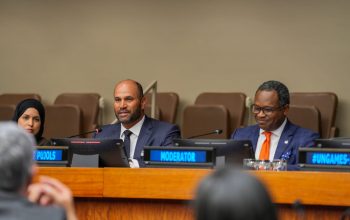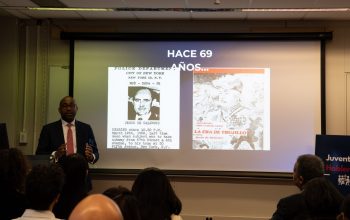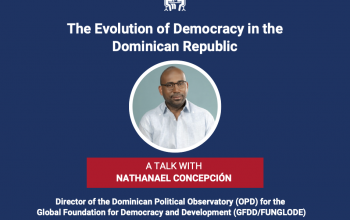news
“Is Globalization Disappearing?”, an article by Dr. Leonel Fernández
March 6, 2017
Within a bit over a month since moving into the White House, president Donald Trump has abandoned the Trans Pacific Partnership Agreement (TPPA), the approval of which had been pending in the US Congress; induced the auto firm Ford to return planned offshore investments to the United States; and harped on the need to renegotiate the North American Free Trade Agreement (NAFTA) with Mexico, which he has deemed “the worst trade deal in history.”
For the current US president, these free trade agreements and the presence of US firms abroad shut down the possibility for jobs for US citizens, weaken the nation’s economic growth, and generate a trade imbalance that runs against US interests.
In an attempt to compel automakers in Mexico to return to the United States, for example, president Trump threatened to levy a tariff of 35 percent that would made the vehicles so expensive that they would be
unsellable in the market north of the border.
Faced with that threat, Ford opted to cancel its investment in the Aztec nation and instead revive a production plant on US soil. Other firms like General Motors, Chrysler, and Toyota have been weighing whether to proceed in the same direction.
These decisions taken by the Trump administration point to a rupture in the longstanding, bipartisan consensus in the United States, in place since the 1980s, to make
the country a leader in an integrated and interdependent world within the framework of globalization.
Now, however, the current US administration is seeking a reversal. Its plan involves reinstalling an old system of trade protectionism and economic nationalism – and thereby negating the functioning of an open system with free circulation of goods, services, investments, financial flows, and people.
In short, in the face of the current model
being advanced by the Trump administration, the following question is warranted: Is globalization disappearing?
Globalization from Below
Having said all the above, the critical view of globalization didn’t begin with the current administration. Since the 1970s opposition has simmered over the way multinationals operate in developing countries.
Then, during the 1980s, a backlash arose amongst progressives in
various parts of Latin America, the Caribbean, Asia, and Africa related to how the International Monetary Fund, the World Bank, and other multilateral bodies operated.
In the 1990s, the struggle was oriented against the disparity or asymmetry that developed between the trade relations of countries at different levels of development.
This struggle was symbolized by the fact that the same day NAFTA went into effect, on January 1, 1994, the Zapatista Army
of National Liberation began its armed insurrection under the command of Subcomandante Marcos.
Later, this campaign for fair trade would erupt in the streets of Seattle, Washington, during the 1999 ministerial meeting of the then-nascent World Trade Organization.
Different sectors comprised this network of organizations confronting what in that era began to be called “neoliberal globalization.” The movement included unions,
environmentalists, human rights activists, agricultural producers, academics, and progressive politicians.
The idea was that globalization, as originally conceived, favored large firms and developed countries, the United States in particular. It was understood to mean globalization from the top down, which could in no way favor the peoples of the world who longed for a better future.
In contrast with this top-down, neoliberal globalization, which
involved indiscriminate liberalization of trade, investment, and capital flows, an alternative model – “alter-globalization,” it was called – was conceived of and aimed to be built by the people, from below, to give concrete form to the slogan of that era: that another world was possible.
The terrorist attacks of September 11, 2001, took the wind out of the sails of the progressive alter-globalization movement. That same year, however, the World Social
Forum was created and has since brought together immense masses in Brazil, India, Venezuela, Nairobi, Dakar, and Tunis.
To this day a movement continues to agitate for the need for new global governance structures, involving, among other things, changes to rules on free trade, investment, and capital flows to make them fairer, more balanced, and better harmonized with the aims of progress and wellbeing for developing nations.
The Return of
Mercantilism
Unlike the progressive movement, with its sustained struggle for a fairer and more balanced globalization, the administration of president Donald Trump, with its policies of economic nationalism, nevertheless attempts to ignore the current levels of integration and interdependence in the global economy in favor of a system – long consigned to the history books – called mercantilism.
The basic aim of mercantilism is to
increase import tariffs to avoid the penetration of foreign firms in the national market and the introduction of competition with local industries.
This was what happened between the 15th and second half of the 18th centuries until the start of the Industrial Revolution. It was also what happened in the period between 1914 and 1930, which ended up unleashing both World War I and the Great Depression.
Because of mercantilism trade wars erupted in which
each nation found itself at the mercy of every other nation to get its products on the market and keep the dynamics of the global economy moving.
Influenced by the ideas of Texan multimillionaire Ross Perot, the independent candidate in the 1992 presidential election, president Trump has come to believe that part of what ails the US economy is that American firms have moved off US soil.
This, however, is not true. The prevailing system of global
production is fragmented, involving the creation of global supply chains and a dislocation of production, in what has come to be called the offshore system.
Firms do it to reduce labor costs, and thereby increase profit levels. But in these global production chains, a large part of the components for a product’s final assembly come from other countries.
For example, in the case of vehicles from US automakers assembled in Mexico, more than 40
percent of the components are imported straight from the United States.
Thus this means that it’s not entirely correct to talk about the presumed trade imbalance favoring Mexico that president Trump so likes to mention. In fact due to importation of US parts for final production of a good, in the end what’s actually happening is a sort of re-export to the US market.
President Trump’s administration is within its rights to
abandon NAFTA, as it has already done with the TPPA. Nonetheless, with these measures, what Trump’s government would aspire to is to modify the current offshore production system, with its emphasis on export processing zones, to a reshoring system.
This would naturally imply a form of deglobalization that’s no longer possible in a world dominated by the current levels of integration, interdependence, and interconnection in the global economy.
To alleviate these problems, what the US economy needs – like the global economy overall – is not a return to the mercantilism already overtaken by history, but the establishment of new rules and institutions to allow for the creation of a fairer, more humane, equitable, and supportive economy.
Related Link:
http://leonelfernandez.com/articulos/se-desvanece-la-globalizacion/






